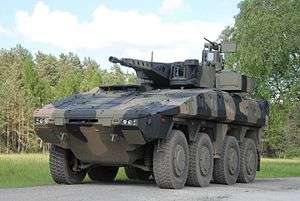Boxer (armoured fighting vehicle)
| Boxer | |
|---|---|
|
Boxer configured for Australian Land 400 Phase 2 | |
| Type | Armoured fighting vehicle |
| Place of origin | Germany/Netherlands |
| Service history | |
| In service | 2008–present |
| Used by | See Operators |
| Specifications | |
| Weight | 24,000 kg (standard); 36,500 kg (combat)[1] |
| Length | 7.93 m (26 ft 0 in) |
| Width | 2.99 m (9 ft 10 in) |
| Height | 2.37 m (7 ft 9 in) (baseline vehicle) |
| Crew | Varies by role. In APC configuration - 3 + maximum of 8[1] |
|
| |
| Armor | AMAP composite armour |
Main armament | various, depends on configuration |
| Engine |
MTU 8V199 TE20 Diesel rated at EURO 3[2] 530 kW (711 hp) |
| Power/weight | 16.1 kW/t (max weight) |
| Suspension | independent double wishbone coil (8x8) |
Operational range | 1,100 km (684 mi) |
| Speed | 103 km/h (64 mph) |
The Boxer is a German-Dutch multirole armoured fighting vehicle designed to accomplish a number of operations through the use of installable mission modules. It is produced by the ARTEC GmbH (ARmoured vehicle TEChnology) industrial group, and the programme is being managed by OCCAR (Organisation for Joint Armament Cooperation). ARTEC GmbH is seated in Munich, its parent companies are Krauss-Maffei Wegmann GmbH and Rheinmetall MAN Military Vehicles GmbH (RMMV) on the German side,[3] and Rheinmetall MAN Military Vehicles Nederland B.V. for the Netherlands.[4] Overall, Rheinmetall has a 64% stake in the joint venture.
Other names in use or previously used are GTK (Gepanzertes Transport Kraftfahrzeug; armoured transport vehicle) Boxer and MRAV for Multirole Armoured Vehicle.
Production history
The Boxer is a cooperative European design project aimed at producing the next generation of armoured utility vehicle. The project was originally started as a joint venture between Germany, Britain and France, but France left the programme in 1999, later to pursue their own design, the Véhicule Blindé de Combat d'Infanterie (VBCI).
Following negotiations, a contract was awarded in November 1999 for eight prototype vehicles, four for Germany and four for the UK. Total value of this contract was £70 million. In February 2001, the Netherlands joined the programme and 12 prototypes were built, four for each of the three countries.[1] On 12 December 2002 the GTK/MRAV/PWV was unveiled in Munich, Germany. The second prototype (PT2) was rolled out and the vehicle was named Boxer. At this time the first production run was to have been for 600 vehicles, 200 for each country.
In July 2003, shortly after the start of the Iraq war, the UK Ministry of Defence announced its intention to withdraw from the Boxer programme and focus on the Future Rapid Effect System (FRES). [1]
The first Dutch prototype was delivered in October 2003.
Production deliveries were scheduled to commence in 2004, but numerous design changes combined with political problems delayed production until 2008, and the first production example was handed over to the German Army on 24 September 2009. Prior to deliveries commencing, the 12 prototypes were put through a series of reliability trials (over 90,000 km) and durability trials (over 90,000 km) over a seven-year period.[1]
The Netherlands confirmed the procurement of 200 Boxer in the autumn of 2006, these to replace the M577 and the support variants of the YPR-765 in the Royal Netherlands Army. Deliveries are from 2013 through to 2018, vehicles coming from the Netherlands production line. Within the RNLA the baseline Boxer is called the Pantser Wiel Voertuig (PWV).
On December 13, 2006 the German parliament approved the procurement of 272 Boxers for the German Army,[5] to replace shares of its M113 and Fuchs TPz 1 vehicles.[6] By September 2011, six German Army Boxer had been upgraded to the Boxer A1 standard. From German Army Boxer No 41 all vehicles have been produced to the A1 standard.
In December 2015 it was announced that Germany had placed a contract for an additional 131 Boxer worth EUR476 million.
There are three production/assembly lines for Boxer, one in the Netherlands (Rheinmetall MAN Military Vehicles Netherland) and two in Germany (Krauss-Maffei Wegmann and Rheinmetall MAN Military Vehicles).[1]
In August 2016 Lithuania placed a EUR390 million contract for 88 Boxer, most of these in IFV configuration, and a small quantity in the command post role.[7] Lithuanian Boxers will be manufactured by Krauss-Maffei Wegmann (53)and Rheinmetall (35) with deliveries running from 2017 through to 2021. In Lithuanian service, Boxer will be known as Vilkas (Wolf).[1]
In June 2017 it was announced that the Bundeswehr's Boxer A1 fleet will upgraded to A2 standard. Original Boxer deliveries were (from vehicle 41) in A1 configuration, with the first A2 configured Boxer delivered in June 2015. The A2 standard resulted from operations in Afghanistan and incorporates belly armour, an IED jammer, and 76 mm smoke grenade launchers. According to the June 2017 announcement "The A2 standard includes a fire suppression system, a driver vision system (consisting of an externally-mounted camera to enhance situational awareness), a satellite communications system, plus increased ballistic protection."[8]
On 4th July 2017 ARTEC awarded Rheinmetall MAN Military Vehicles (RMMV) a contract to upgrade 38 Bundeswehr Boxer command vehicles to A2 configuration. The value of the contract was stated to be €21 million. Work is scheduled for completion in mid 2020. The Bundeswehr also has 124 Boxer APCs, 72 ambulances and twelve driver training vehicles to upgrade to A2 status.[9]
Design
The Boxer is an eight-wheeled multirole vehicle, which at the time of its development easily dwarfed most contemporary vehicles with its size. With a combat weight of 33 tonnes,[10] it was also about 10 tonnes heavier than many of its contemporaries. In recent years the size/weight differences between Boxer and its contemporaries has reduced considerably, with Boxer quoted to have a combat weight of 36,500 kg in 2016,[11] while vehicles such as ST Kinetics' Terrex 3 had a quoted combat weight of 35 tonnes, and Nexter's VBCI, Patria's AMV and General Dynamics' Piranha V all weighing in around the 32 to 33 tonne mark.[12][13][14]
Boxer consists of two key elements, the platform/drive-line and the removable mission module.
The platform has the driver located front right, with the power pack to the left. The MTU/Allison powerpack can be replaced under field conditions in about 20 minutes and can, if required, can be run outside of the vehicle for test purposes. Boxer is full-time all-wheel drive, the front four wheels steering. Suspension is double-wishbone coils, independent all round. Tyres are 405/80 R 27 and a central tyre inflation system and run-flat inserts are fitted.[1]
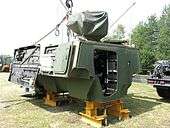
The mission module is a key (and unique) feature of Boxer, it allowing the vehicle to be rapidly changed to meet different operational requirements. Mission modules are attached by four points and can be swapped within an hour under field conditions. Mission modules ordered by Germany and the Netherlands are:
- Ambulance (Germany and Netherlands)
- Armoured personnel carrier (Germany and Netherlands)
- Battle damage repair (Netherlands)
- Cargo (Netherlands)
- Command post (Germany, Lithuania, Netherlands)
- Engineer group (Netherlands)
- Infantry Fighting Vehicle (Lithuania)
The Netherlands Boxer order originally comprised 60 command post, 52 ambulance, 27 cargo, 53 engineer group and eight driver training vehicles. In May 2016 the order was amended to include 92 engineer group, 12 cargo and 36 command post, totals remaining 200. 12 of the 92 engineer vehicles will now be converted to battle damage repair configuration.[1]
The initial German Boxer order comprised 125 armoured personnel carriers, 72 ambulance, 65 command post and 10 driver training vehicles. All 131 vehicles from the second order will be in a new configuration of the armoured personnel carrier (Gepanzertes Transportfahrzeug) and in A2 configuration.
Other module options are numerous and include a 155 mm/52-calibre gun. Krauss-Maffei Wegmann (KMW) has developed the 155 mm/52-calibre Artillery Gun Module (AGM) as a private venture.[15] KMW has also fitted a Boxer IFV variant with a further development of the unmanned turret originally developed for installation on the Puma AIFV, this in production for the German Army. Rheinmetall's Boxer IFV is fitted with their Lance two-person turret armed with the Rheinmetall Mauser MK30-2 air bursting munition (ABM) dual-feed stabilised cannon and 7.62 mm coaxial MG. Rheinmetall has also fitted a Boxer with a 20 kW high energy laser (HEL) system with the 5 kW/10 kW HEL integrated in the rear mission module. Boxer is also the probable platform of the German army's future SysFla anti aircraft system, incorporating the LFK NG missile and the MANTIS gun system
Armament
Most Boxers are equipped with a remote weapon station for self-defense. Dutch vehicles are fitted with the Protector M151 RWS from Kongsberg fitted with a 12.7 mm heavy machine gun. German vehicles are usually fitted with the FLW-200 from KMW, which can be fitted with either a 7.62 mm MG3 machine gun, a 12.7 mm M3M HMG or a 40 mm GMW automatic grenade launcher. The FLW-200 has dual-axis stabilization and incorporates a laser rangefinder and a thermal imager. As possible firepower upgrade KMW has developed the FLW-200+ and presented it mounted on top of a Boxer APC at Eurosatory 2012.[16] The FLW-200+ allows the usage of a 20 mm autocannon like the Rheinmetall Rh 202 with 100 rounds loaded at the gun. The RWS is two-axis stabilized and is fitted with a CCTV camera, thermal imager and laser rangefinder.[16]
Lithuanian Boxers will be fitted with the Israeli-made RAFAEL Samson Mk II enhanced survivability multiple weapon station with a 30 mm gun and Spike-LR anti-tank missiles capable of destroying targets out to 4 km (2.5 mi).[17]
Protection
The Boxer is constructed from rolled all-welded steel armour. On top of the steel, passive AMAP composite armour is fitted with shock-proof mounting bolts.[18] Exact details of Boxer protection levels have now been classified. According to ARTEC, the vehicle will withstand anti-personnel and large anti-tank mines of an undisclosed type under the wheel, platform or side attack. It has previously been stated that Boxer's baseline armour is all-round resistant to 14.5 mm armour-piercing ammunition in accordance with STANAG 4569 Level 4. To increase survivability in case of armour penetration, the crew compartment is completely covered by an AMAP-L spall liner. The spall liner stops most of the fragments of the armour and projectile brought about by hull penetration. To further enhance crew protection, the seats are decoupled from the floor, this preventing the shock of a mine-detonation being directly transmitted to the crew. The roof armour of the Boxer is designed to withstand artillery fragments and top attack weapons such as bomblets fitted with a High-Explosive Anti-Tank (HEAT) warhead.
Mobility
_Boxer_-_Motor.jpg)
The power pack of Boxer consists of a MTU 8V199 TE20 diesel developing 720 hp and coupled to an Allison HD4070 fully automatic transmission with seven forward and three reverse gears. Boxer has full time 8 × 8 drive with differential locks on all axles. The front four wheels steer, tyres being 405/80 R27 Michelin XML on German and Dutch Boxers. A central tyre inflation system (CTIS) is fitted, and run-flat inserts allow for 100 km of driving following deflation. Suspension is of the fully independent double wishbone type with coil springs.[19] Boxer can be transported in the Airbus A400M tactical airlifter.
Variants
The German and Dutch base vehicles are virtually identical, the mission modules the only significant difference.
Dutch variants[20]
- Boxer CP (Boxer Command Post) — The Command Post variants of Boxer are used for command and control in theatre, acting as a centre for tactical communications. Secured communication, displays for situational awareness and instruments for network enabled warfare are key characteristics of this variant.[21] The vehicle offers room for four workstations connected via local area network to the Battlefield Management System (BMS) and the Theater Independent Army and Air Force Network (Titaan). The crew consists of driver, commander/weapon operator, two staff officers, one staff assistant and one additional crew member.[19]
- Amount ordered: 36
- Boxer AMB (Boxer Ambulance) — The Boxer AMB replaced the [[AIFV#Dutch variants[2]|YPR-765 prgwt]] variant of the AIFV (Armored Infantry Fighting Vehicle) casualty transport. It can accommodate seven casualties that are seated, or three lying down on stretchers. Or one of the following combinations: three seated and two lying down, or four seated and a single casualty lying down. The crew consists of driver, commander and a single medic.
- Amount ordered: 52
- Boxer GNGP (Boxer Geniegroep) - The Boxer GNPR is an engineering and logistics support vehicle and will be deployed for the transport of troops and engineer group equipment. It provides seating for six dismounts with space available for their personal equipment and an additional separate stowage section for munitions. It may be deployed as a support vehicle with other units or used for independent assignments such as route clearance, or as a protected work location during mine clearance or demolition operations.[22] The Boxer GNGP replaces the [[AIFV#Dutch variants[2]|YPR-765 prgm/PRCO-C3]] variant of the AIFV (Armored Infantry Fighting Vehicle). The Royal Netherlands Army will now convert 12 of the 92 GNGP vehicles to Boxer Battle Damage Repair. (BDR) configuration. The BDR variant is able to accommodate the special equipment, tools, expendable and non-expendable supplies needed to carry out diagnoses, maintenance and minor repairs if required.[23] Crew consists of an engineer commander, driver, observing commander, gunner, and five engineers.
- Amount ordered: 92 (12 to be converted to BDR configuration)
- Boxer Cargo (Boxer Cargo) — The Boxer Cargo replaces the [[AIFV#Dutch variants[2]|YPR-765 prv]] variant of the AIFV (Armored Infantry Fighting Vehicle). It is equipped with a special loading floor to secure cargo during transport and can transport a maximum of two standard one tonne army pallets (max. load 2,5 t[24]). The interior design of the vehicle allows adaptation as necessary for different kinds of missions. For conducting peace keeping missions or other peace time operations the set of vehicle equipment can be changed and tailored to suit as required.[25] Crew consists of commander/gunner and driver.
- Amount ordered: 12
- Boxer DTV (Boxer Driver Training Vehicle) — This variant is equipped with a training module. The driver sits in the conventional driver’s station and the instructor is seated in an elevated position in the driver training cabin. Active occupant protection is designed to protect the crew sitting exposed in the driver training cabin. In the event of a roll-over accident, the instructor and upper occupant seats are electronically retracted into the Driver Training Module. In normal use, the instructor can monitor the trainee driver via a duplicated control and display unit and override gear selector, brake and accelerator pedal of the driver’s station. Steering override is available as an option.[26] Crew consists of a trainee driver, instructor, plus up to two additional trainee passengers
- Amount ordered: 8
Gallery
- ARTEC Boxer
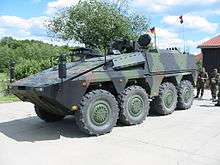 A prototype Boxer seen in 2004. Production deliveries were scheduled to commence in 2004, but numerous design changes combined with political problems delayed production until 2008
A prototype Boxer seen in 2004. Production deliveries were scheduled to commence in 2004, but numerous design changes combined with political problems delayed production until 2008_Boxer_in_Zeithain.jpg) The Boxer is a German-Dutch multirole armoured vehicle designed to accomplish a number of operations through the use of installable mission modules
The Boxer is a German-Dutch multirole armoured vehicle designed to accomplish a number of operations through the use of installable mission modules German Army Boxer in ambulance configuration. The German and Dutch base vehicles are virtually identical, mission modules and fitments the only significant difference
German Army Boxer in ambulance configuration. The German and Dutch base vehicles are virtually identical, mission modules and fitments the only significant difference Most Boxers are equipped with a remote weapon station for self-defense. German vehicles are usually fitted with the FLW-200 from KMW
Most Boxers are equipped with a remote weapon station for self-defense. German vehicles are usually fitted with the FLW-200 from KMW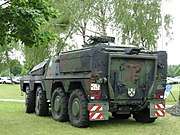 From the rear, a German Army Boxer fitted with a FLW 200 RWS
From the rear, a German Army Boxer fitted with a FLW 200 RWS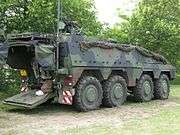 Dutch Army Boxer in command post configuration - 36 of which were ordered
Dutch Army Boxer in command post configuration - 36 of which were ordered- Driver training variant of Boxer being transported by a Faun SLT Elefant HET
 Prototype of Lithuanian Army Vilkas (Boxer) IFV.
Prototype of Lithuanian Army Vilkas (Boxer) IFV.
Operators

Current operators
-
 German Army - 403 vehicles, deliveries until 2018
German Army - 403 vehicles, deliveries until 2018 -
 Royal Netherlands Army - 200, deliveries from 2013 until 2017.
Royal Netherlands Army - 200, deliveries from 2013 until 2017. -
 Lithuanian Land Force - On December 11, 2015 Lithuania decided to buy 88 Boxer armored vehicles armed with Israeli RAFAEL Samson Mk II enhanced survivability multiple weapon stations.[27] The order, worth €385.6 million, was placed on 22 August 2016 and will run from 2017 to 2021. In Lithuanian service these vehicles will be known as IFV Vilkas (Vilkas being Lithuanian for wolf).[7][28]
Lithuanian Land Force - On December 11, 2015 Lithuania decided to buy 88 Boxer armored vehicles armed with Israeli RAFAEL Samson Mk II enhanced survivability multiple weapon stations.[27] The order, worth €385.6 million, was placed on 22 August 2016 and will run from 2017 to 2021. In Lithuanian service these vehicles will be known as IFV Vilkas (Vilkas being Lithuanian for wolf).[7][28]
Potential future operators
-
 Australian Army — On 28 July 2016 it was announced the Boxer IFV variant was one of two vehicle types (from four) down-selected to take part in the 12-month Risk Mitigation Activity for the Australian Army's Mounted Combat Reconnaissance Capability, also known as the Land 400 Phase 2 programme. The CRVs are being sought to replace the army's ageing fleet of 250 Australian Light Armoured Vehicles (ASLAV) that reach their life-of-type around 2021. Contract award is expected in early 2018.[29]
Australian Army — On 28 July 2016 it was announced the Boxer IFV variant was one of two vehicle types (from four) down-selected to take part in the 12-month Risk Mitigation Activity for the Australian Army's Mounted Combat Reconnaissance Capability, also known as the Land 400 Phase 2 programme. The CRVs are being sought to replace the army's ageing fleet of 250 Australian Light Armoured Vehicles (ASLAV) that reach their life-of-type around 2021. Contract award is expected in early 2018.[29] -
 Romanian Army — In November 2016, Romanian Prime Minister Dacian Cioloș announced a deal with Rheinmetall to build armored personnel carriers to replace the Soviet-era BTR-70-based TAB vehicles currently in service with the Romanian Armed Forces. The deal includes no direct reference to the Boxer vehicle, but does include a joint venture structure with a local manufacturing clause, meant to generate jobs in Romania. Although not confirmed, it is possible that the Boxer vehicle could form the basis of this new program.[30]
Romanian Army — In November 2016, Romanian Prime Minister Dacian Cioloș announced a deal with Rheinmetall to build armored personnel carriers to replace the Soviet-era BTR-70-based TAB vehicles currently in service with the Romanian Armed Forces. The deal includes no direct reference to the Boxer vehicle, but does include a joint venture structure with a local manufacturing clause, meant to generate jobs in Romania. Although not confirmed, it is possible that the Boxer vehicle could form the basis of this new program.[30] -
 British Army — In October 2016, it was reported that the British Ministry of Defence took its first formal step, a preliminary market engagement, for government-to-government acquisition of up to 900 Boxer vehicles.[31]
British Army — In October 2016, it was reported that the British Ministry of Defence took its first formal step, a preliminary market engagement, for government-to-government acquisition of up to 900 Boxer vehicles.[31]
References
- 1 2 3 4 5 6 7 8 9 "GTK/MRAV/PWV (Boxer) Wheeled Armoured Vehicle Programme". IHS Jane's Christopher F Foss. 2016-10-21. Retrieved 2017-03-23.
- ↑ "MTU Shop". Mtu-online-shop.de. Retrieved 20 November 2014.
- ↑ "Rheinmetall MAN Military Vehicles GmbH". Rheinmetall Defence. Retrieved 2015-09-10.
- ↑ "Rheinmetall MAN Military Vehicles Nederland B.V.". Rheinmetall Defence. Retrieved 2015-09-10.
- ↑ "German Parliament Approves Boxer Acquisition". Defense-update.com. Retrieved 2006-12-13.
- ↑ "Germany orders 131 more Boxers". Jane's Defence Weekly. Retrieved 2017-03-24.
- 1 2 "Lithuania joins Boxer programme". www.yourindustrynews.com. OCCAR. Retrieved 22 August 2016.
- ↑ "Bundeswehr Boxer upgrade gets green light". Jane's Defence Weekly. Retrieved 2017-06-28.
- ↑ "Rheinmetall to modernize the Bundeswehr’s Boxer command vehicles". Rheinmetall Group. Retrieved 2017-07-04.
- ↑ Foss, Christopher F (2006-07-24). "GTK/MRAV/PWV (Boxer) Wheeled Armoured Vehicle Programme". IHS Jane's. Retrieved 2016-11-11.
- ↑ Foss, Christopher F (2016-10-21). "GTK/MRAV/PWV (Boxer) Wheeled Armoured Vehicle Programme". IHS Jane's. Retrieved 2016-11-11.
- ↑ Felstead, Peter (2016-06-15). "Eurosatory 2016: ST Kinetics launches Terrex 3 IFV". IHS Jane's. Retrieved 2016-11-11.
- ↑ Foss, Christopher F (2016-01-01). "Patria awaits first contract for latest AMV XP". IHS Jane's. Retrieved 2016-11-11.
- ↑ "VBCI: France’s Wheeled APC". Defense Industry Daily. 2014-10-13. Retrieved 2016-11-11.
- ↑ KMW unveils AGM-mounted Boxer - Shephardmedia.com, 20 June 2014
- 1 2 Elbertzhagen, Timo. "GTK Boxer im Einsatz in Afghanistan - erste Erfahrungen" (PDF). Wehrtechnik (IV/2012). Mönch Publishing Group. Retrieved 23 September 2015.
- ↑ Boxer Infantry Fighting Vehicles For Lithuania's Iron Wolves - Aviationweek.com, 22 August 2016
- ↑ Nitschke, Stefan. "Schutz bei Rad- und Kettenfahrzeugen - Teil 1" (PDF). Wehrtechnik (Wehrtechnik I 2011 page 52-57). Mönch Publishing Group. Retrieved 23 September 2015.
- 1 2 "GTK/MRAV/PWV (Boxer) Wheeled Armoured Vehicle Programme May 2017". IHS Jane's Christopher F Foss. 2017-05-03. Retrieved 2017-05-03.
- ↑ "Boxer". Defensie.nl. Retrieved 20 November 2014.
- ↑ "artec-boxer.com: Command Post Vehicles". Artec-boxer.com. Retrieved 20 November 2014.
- ↑ "artec-boxer.com: Armoured Engineer Group Vehicle". Artec-boxer.com. Retrieved 20 November 2014.
- ↑ "artec-boxer.com: Battle Damage Repair Vehicle". Artec-boxer.com. Retrieved 20 November 2014.
- ↑ Gerhard Heiming: Erster Boxer in Transportversion, Europäische Sicherheit & Technik, Ausgabe 5/2016, S. 7.
- ↑ "artec-boxer.com: Cargo Vehicle". Artec-boxer.com. Retrieved 20 November 2014.
- ↑ "artec-boxer.com: Driver Training Vehicle". Artec-boxer.com. Retrieved 20 November 2014.
- ↑ "Lithuania to proceed with Germany’s Boxer in armoured vehicle purchase". Reuters. December 11, 2015. Retrieved December 11, 2015.
- ↑ "Minister J. Olekas: "The Contract of 88 IFV is the signal that Lithuania takes care of its security and investments into it seriously". Ministry of National Defence of the Republic of Lithuania. August 22, 2016. Retrieved August 22, 2016.
- ↑ Kerr, Julian (28 July 2016). "Australia shortlists AMV35, Boxer for future combat reconnaissance vehicle". Jane's IHS. Retrieved 29 July 2016.
- ↑ Adamowski, Jaroslaw (18 November 2016). "Romania to Award Armored Vehicles Deal to Germany's Rheinmetall". Defense News. Warsaw, Poland. Retrieved 19 November 2016.
- ↑ Chuter, Andrew (26 October 2016). "Britain's Soft Spot for Germany's Boxer Vehicle Raises Eyebrows in Industry". Defense News. Retrieved 27 October 2016.
External links
| Wikimedia Commons has media related to GTK Boxer. |
- Boxer – Infantry fighting vehicle
- Boxer CRV for Land 400
- Artec Boxer
- Army Technology Boxer Information
